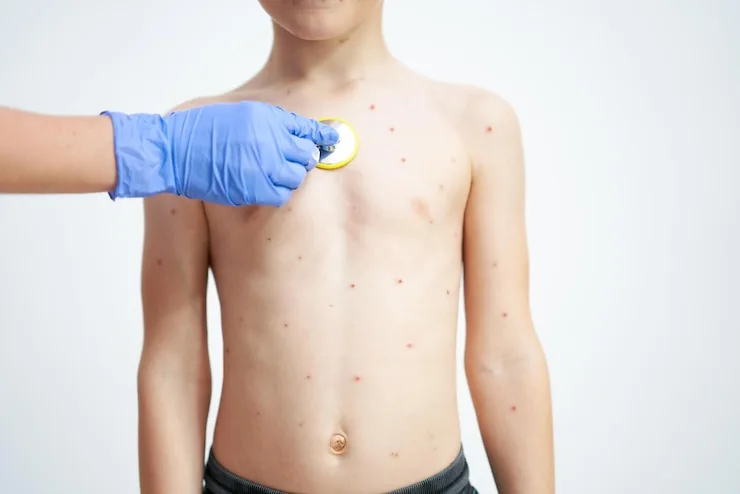Why Identifying Measles Symptoms Early Is Crucial
Measles is making a comeback, and it’s not the type of party anyone wants to attend. It’s a highly contagious virus, often spreading faster than a rumor in school. Early identification of measles symptoms isn’t just important; it’s vital. The sooner you spot it, the sooner you can protect yourself, your family, and others around you. So, if you know what to look for, you can catch it early and stop it from spreading.
But how can you tell if that fever and runny nose are something more serious than the common cold? This guide will break down how to identify measles symptoms early, ensuring you stay ahead of the game.
2. What is Measles? A Quick Overview
Measles is a viral infection that’s contagious, spreading through coughing, sneezing, and even talking. It was nearly eradicated worldwide due to vaccines, but unfortunately, it’s making a return in some areas due to lower vaccination rates. While it mostly affects children, adults who weren’t vaccinated as kids can still get it.
The virus can spread before symptoms even appear, which makes it tricky. If you spot the symptoms early, you can avoid spreading it to others and get the proper treatment.
Read Also: How to Stay Safe During a New Virus Spreads
3. Recognizing the Early Symptoms of Measles
Measles doesn’t just surprise you with its rash. The early symptoms can resemble the common cold, which is why it can be tough to figure out. Here’s what you need to look out for:
Fever
It starts like any other viral infection fever. But here’s the kicker: the fever gets pretty high. It can go above 104°F (40°C), which is a clear sign that it’s not just a regular bug. It tends to start mild but increases steadily over a couple of days.
Cough
A dry, persistent cough is another telltale sign. It might remind you of a flu cough, but the fact that it comes alongside the fever is something to keep an eye on.
Runny Nose
A runny nose (also known as coryza) is another early sign. It’s often one of the first things to appear before other symptoms pop up.
Red Eyes (Conjunctivitis)
You’ve probably heard of “pink eye” well, measles can cause a very similar symptom. Your eyes might become red, itchy, and sensitive to light. This is usually one of the first things that signal something’s not quite right.
Sore Throat
A scratchy, sore throat can also be a symptom. If your throat hurts along with other symptoms like fever and cough, it’s definitely time to investigate further.
Fatigue
You’re going to feel tired, and not just the “I didn’t sleep well” kind of tired. Measles fatigue is like being drained after running a marathon, even though you haven’t moved much. It’s common to feel sluggish during the early stages.
4. Koplik Spots: The Key to Early Diagnosis
Now, here’s where measles gets a little extra. There’s a very specific symptom that acts like a measles secret handshake: Koplik spots. These are tiny, white spots that appear inside the mouth, usually on the inner cheek. They might look like little grains of salt, but don’t be fooled they are a dead giveaway for measles.
Koplik spots appear a couple of days before the rash shows up, making them a key part of early identification. If you spot these little spots, you’ve got a solid clue that measles might be the culprit.
5. The Measles Rash: When It Appears and How to Spot It
The rash is the star of the show when it comes to measles. But here’s the trick: the rash doesn’t appear immediately. It shows up about 3 to 5 days after the fever starts. It often starts at the hairline or behind the ears and spreads down the body.
It doesn’t just stay as little red bumps; the rash can start to merge into large patches that are hard to miss. It’s usually flat at first, but as it develops, it becomes raised and blotchy. The good news is that when the rash appears, the fever tends to start going down, so that’s a sign of progress.
6. Differentiating Measles Symptoms from Other Common Illnesses
Measles vs. Common Cold
A cold starts with a stuffy nose and sore throat, but measles brings on a fever and rash. If the fever is high, and you see red eyes and a cough, it’s more likely to be measles, not a simple cold.
Measles vs. Chickenpox
Chickenpox and measles might seem similar with their rashes, but they have different patterns. Chickenpox rash usually appears on the trunk and spreads outward. Measles rash, however, starts at the hairline and moves down the body. Also, chickenpox blisters are fluid-filled, while measles spots are flat and red.
Measles vs. Flu
Flu and measles both involve fever and cough, but measles includes the telltale rash and Koplik spots, which aren’t seen in the flu. The flu might make you feel bad, but it’s measles that can bring a rash and more serious complications.
7. When to Seek Medical Attention
If you suspect measles, don’t wait around hoping it’s just a cold. Measles can lead to serious complications, like pneumonia and encephalitis (brain inflammation). So, when should you head to the doctor?
-
High Fever: If the fever is 104°F or higher and doesn’t go down with normal fever-reducing medicine.
-
Koplik Spots: If you spot those white spots inside the mouth, it’s time to call the doctor.
-
Rash Spreading: If the rash shows up and spreads quickly, seek medical advice immediately.
If you or your child are experiencing any of these symptoms, it’s better to be safe than sorry. Catching measles early can prevent long-term complications.
8. How Measles Spreads and Why Early Detection Helps Contain It
Measles is extremely contagious. It spreads through the air when an infected person coughs, sneezes, or even talks. Someone with measles can spread the virus for up to four days before the rash appears.
The earlier you catch it, the easier it is to prevent the spread. Isolating the infected person from others, especially those who haven’t been vaccinated, can help contain the outbreak. This is why early identification is key not just for treatment, but also for public health.
9. Preventing Measles: Vaccination and Other Preventative Measures
MMR Vaccine
The best way to prevent measles is through the MMR vaccine (Measles, Mumps, Rubella). It’s a safe and effective way to protect yourself and your family from the virus. The first dose is typically given at 12 months, and the second dose comes around ages 4-6.
Vaccination Schedule
Following the recommended vaccination schedule is your best defense. If you’re an adult who didn’t get vaccinated as a child, it’s not too late. Talk to your healthcare provider about getting vaccinated.
Herd Immunity
When most people are vaccinated, it creates herd immunity, which means the virus has a harder time spreading. This is especially important for people who can’t get vaccinated, like infants and those with weakened immune systems.
10. Conclusion: Early Identification Is Key to Preventing Complications
Measles might seem like an old problem, but it’s still around, and it’s still dangerous. Identifying the symptoms early especially the fever, cough, Koplik spots, and rash—can help you get the right treatment and avoid serious complications. And remember, vaccination is the best way to prevent measles from becoming a problem in the first place.
Stay aware, stay informed, and if in doubt, get checked out. Early detection saves lives, and you can help keep your community safe by knowing the signs.
FAQs about Measles Symptoms
1. What are the first signs of measles?
The first signs are fever, cough, runny nose, sore throat, and red eyes. Fatigue and body aches often follow.
2. How long does it take for measles symptoms to show up?
Symptoms typically appear 10-14 days after exposure, with fever and cough being the first signs, followed by the rash.
3. What are Koplik spots?
Koplik spots are small, white spots inside the mouth, a key indicator of measles, appearing 2-3 days before the rash.
4. Can measles be mistaken for something else?
Yes, it can be confused with the flu, cold, or chickenpox. The rash and Koplik spots help confirm it.
5. When should I see a doctor?
If you have a high fever, cough, and rash, consult a doctor right away. Early treatment is crucial.
6. Can measles be prevented?
Yes, through the MMR vaccine, which provides long-term protection.
7. How long is someone with measles contagious?
Measles is contagious 4 days before and 4 days after the rash appears.
8. What should I do if I think I have measles?
Stay home, avoid contact with others, and call a doctor for diagnosis and advice.






